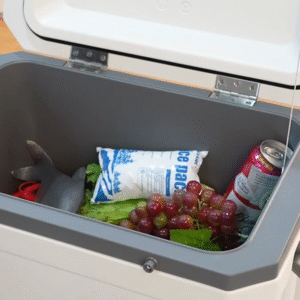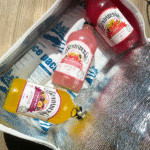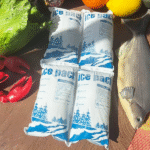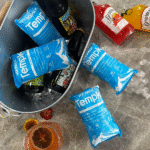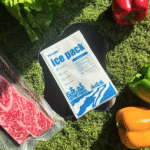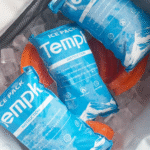Envío de mercancías perecederas, especialmente en condiciones de cuarentena, Requiere un control preciso de la temperatura para preservar la integridad de los productos.. Paquetes de hielo seco en cuarentena son esenciales para garantizar que elementos como productos farmaceuticos, vacunas, y muestras biotecnológicas permanecer intacto durante el transporte. En este artículo, Exploraremos cómo funcionan las bolsas de hielo seco de cuarentena., sus ventajas, y mejores prácticas para integrarlos en la logística de su cadena de frío.
-
¿Qué son las bolsas de hielo seco de cuarentena y cómo funcionan??
-
¿Qué industrias se benefician más de las bolsas de hielo seco de cuarentena??
-
¿Cómo se comparan las bolsas de hielo seco de cuarentena con otros métodos de enfriamiento??
-
Mejores prácticas para el manejo y embalaje seguro con hielo seco.
¿Qué son las bolsas de hielo seco de cuarentena y cómo funcionan??
Paquetes de hielo seco en cuarentena son soluciones de refrigeración especializadas que proporcionan un entorno continuo de baja temperatura al sublimarse de sólido a gas a -78,5 °C. Se utilizan para transportar mercancías que deben mantenerse congeladas., como vacunas, muestras de biotecnología, y alimentos congelados.
El proceso de sublimación del hielo seco garantiza que no deje residuos líquidos., lo que lo hace ideal para envíos de alto valor donde cualquier humedad podría dañar la mercancía. Hojas de hielo seco son versátiles, Adaptándose a diversas soluciones de embalaje., Y se utilizan comúnmente en la logística de la cadena de frío nacional e internacional..
Beneficios del uso de bolsas de hielo seco en cuarentena
-
Enfriamiento confiable y consistente: Las bolsas de hielo seco ofrecen un enfriamiento estable en largas distancias sin derretirse ni causar daños por agua..
-
Efectividad duradera: El hielo seco mantiene bajas temperaturas durante 24-72 horas, reducir el deterioro durante tiempos de envío prolongados.
-
Opciones de embalaje flexibles: Las láminas de hielo seco pueden adoptar varias formas, haciéndolos ideales para diversas necesidades de envío.
-
Rentable: A pesar del mayor costo inicial, La longevidad y el poder de enfriamiento del hielo seco reducen el deterioro., ahorrar dinero a largo plazo.
¿Cómo se comparan las bolsas de hielo seco en cuarentena con otros métodos de enfriamiento??
Al considerar soluciones de refrigeración alternativas como paquetes de gel, materiales de cambio de fase (PCM), y nitrógeno líquido, El hielo seco destaca por sus requisitos de temperatura extrema..
| Método de enfriamiento | Rango de temperatura | Lo mejor para envíos a largo plazo | Efectividad para productos congelados |
|---|---|---|---|
| Hielo seco | -78.5°C | Ideal para larga duración, envíos de alto valor | Excelente para productos congelados |
| Paquetes de gel | 0° C a -20 ° C | Uso a corto plazo en condiciones moderadas. | No es efectivo para congelar |
| PCM | Varía | Rangos de temperatura específicos | Limitado para temperaturas ultrabajas |
| Nitrógeno líquido | -196°C | Extremadamente frío pero complejo de manejar. | Más riesgoso y más difícil de gestionar |
El hielo seco es la mejor opción para transportar productos congelados por largos períodos, especialmente en comparación con los paquetes de gel o PCM.
Cómo las bolsas de hielo seco en cuarentena mejoran la logística de la cadena de frío
La gestión eficiente de la cadena de frío es fundamental para garantizar un transporte seguro. El hielo seco ofrece las siguientes ventajas:
Cumplimiento normativo
Paquetes de hielo seco en cuarentena ayudar a mantener el cumplimiento de las regulaciones de la industria, como los establecidos por el FDA, IATA, y PUNTO. Estas regulaciones requieren monitoreo y control confiable de la temperatura durante el envío..
Integridad mejorada del producto
Para artículos sensibles como muestras de biotecnología y vacunas, El hielo seco garantiza que los productos se mantengan dentro del rango de temperatura requerido., preservando su calidad y eficacia.
Mejora de la satisfacción del cliente
Enviar productos que lleguen a tiempo e intactos aumenta la satisfacción del cliente.. El hielo seco ayuda a prevenir el deterioro y garantiza la seguridad., entrega oportuna.
Mejores prácticas para el uso de bolsas de hielo seco en cuarentena
1. Calcule la cantidad correcta de hielo seco
Asegúrese de utilizar la cantidad correcta de hielo seco según las duración del envío, tipo de producto, y condiciones de embalaje. Típicamente, 1-2 libras de hielo seco por 24 Se recomienda horas de tránsito.
2. Embalaje y ventilación adecuados
Coloque siempre hielo seco en el fondo del embalaje para garantizar que el aire frío se disipe.. También, dejar espacio para Gas co₂ escapar para evitar la acumulación de presión.
3. Utilice el monitoreo de temperatura en tiempo real
incorporando sensores de iot y registradores de temperatura en su solución de envío garantiza que pueda realizar un seguimiento de la temperatura durante todo el viaje y abordar cualquier problema con prontitud.
Últimas tendencias en envíos de hielo seco en cuarentena
Innovaciones en empaquetado de hielo seco
-
Embalaje inteligente: Monitoreo en tiempo real de temperatura y humedad garantiza condiciones óptimas durante el tránsito.
-
Sostenibilidad: Los avances en materiales de embalaje ecológicos reducen el impacto ambiental del hielo seco.
Creciente demanda en los sectores biotecnológico y farmacéutico
Como industrias como biotecnología y productos farmaceuticos expandir, La demanda de hielo seco para el transporte de productos sensibles a la temperatura sigue creciendo.. El aumento en Vacunas de ARNm ha impulsado particularmente esta demanda.
Preguntas frecuentes
Q1: ¿Cuánto dura el hielo seco durante el envío??
El hielo seco generalmente dura 24-72 horas dependiendo de factores como embalaje, aislamiento, y temperaturas exteriores. Calcula siempre la cantidad necesaria para tu envío.
Q2: ¿Es seguro el hielo seco para el envío??
Sí, El hielo seco es seguro para el envío siempre que se manipule y empaquete correctamente.. Garantizar la adecuada ventilación y etiquetado para cumplir con las regulaciones.
Q3: ¿Se puede utilizar el hielo seco para enviar alimentos?
Sí, El hielo seco se usa ampliamente para enviar. comida congelada y mariscos, manteniendo su calidad durante el tránsito.
Conclusión y recomendaciones
Las bolsas de hielo seco de cuarentena son esenciales para garantizar el transporte seguro de mercancías sensibles a la temperatura. Proporcionan un confiable, de larga duración, y solución rentable para el envío de productos como productos farmacéuticos, muestras de biotecnología, y mariscos. Integrando hielo seco en sus procesos de envío, puedes reducir el deterioro, Mejorar la satisfacción del cliente, y cumplir con las regulaciones.
Listo para optimizar la logística de su cadena de frío? Póngase en contacto con Tempk hoy para obtener más información sobre cómo nuestras soluciones de hielo seco pueden ayudar a garantizar el transporte seguro de sus productos..






